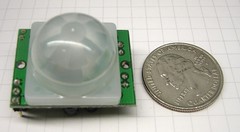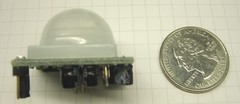


These are some of the smallest integrated PIR sensor units you can find, plus they are pretty cheap. They actually are a bit larger than I had thought before I purchased them, but still they are really small compared to the units you typically find for security purposes.
I didn't know what to expect with regards to performance, but I tested them and they were capable of detecting motion out to at least 15 feet away. They take 3.3V to 5V supply voltage and have 3.3V output logic.
Their small size makes them useful for applications where you might want to put them at the end of a tube to create motion detectors with a very thin field of view.
12 comments:
You mention putting the sensor at the end of a tube to reduce the field of view. Have you tested this? I think it actually might not work. The sensor has to sense change, if the full sensor is exposed to passive infrared, the signal will cancel each other out. This is the nature of the sensor. However I might be wrong...let me know if you tested it.
Yep, I tested putting the Parallax PIR sensor at the end of a PVC pipe, and indeed it restricted motion detection to a small area in front of the pipe. The pipe I used was just thick enough that the entire lens of the sensor could fit in.
PIR sensor elements operate on the difference of IR illumination between the two elements of the sensor.
The plastic lens focuses IR so that if you move around in front of it, your IR jumps back and forth between the two sensors, and the sensor looks for the change between the two sensors.
Here is more info on PIR motion detectors:
How Infrared motion detector components work.
hi...I just purchased one of these to work up a circuit to let me know when the parking spots in front of my apartment become available....
ive just started testing it by running it @ 3.5 volts and connecting the out put to a simple red led + resistor on a breadboard
and so far i havent had much luck...it just keeps flashing more like a timer than a sensor.
I left it in a room alone for about 15 minutes and it appeared to flash the entire time. I have tried both positions for the jumper
Do you think I got a defective one?
Bad news: PIR sensors only detect warm things (like people), and then they only detect their movement (if you don't move, it doesn't detect you).
You would probably be better off using a sonar sensor from Maxbotix.
Good luck!
no...the problem was that it was stuck in the "calibration mode" though it supposedly works from 3.3 volts to 5 it wouldnt work @ the lower voltage. I tried it again @ 5 and it works quite well.
you had tried using the sensor to reduce the field of view.....i wonder if you used a couple of lenses in there as well if you coul d extend the range.
hi...I just purchased one of these to play with it
I've tried running it at 3.3 and 5 volts on a bread board. with a red LED+resistor connected to the out.
All it does is flash right when i turn on the power supply. then after about 20 seconds it flashes on and off every few seconds.
Am i doing something wrong is is something wrong with the sensor.
Hi,
I'm doing a home project and need to buy a solid state relays for DC load switchingThe project consists of A PIR sensor connected to a 6 Volts DC motor. To accomplish this I need a solid state relays (Mosfet) for DC load switching of the motor.
Specifications
Voltage range of output 4.8VDC - 7.2V (motor)
Input
Min turn-on voltage/current 3.3VDC / <100uA (PIR Sensor)
Max turn-on voltage/current 5VDV / <100uA (PIR Sensor)
Min turn-off voltage 1VDC
Output
Current at max.efficiency 4.5 amps (motor)
Max. permissible current 9 amps (motor)
Normal Voltage 6V (motor)
Input power 45W (motor)
Can you please tell me what is the best mosfet to buy this type of system?
Thanks
You can final all the solid state relays you could ever imagine here at Mouser.
Look for a control voltage, load voltage, and load current you need.
Thanks 't11s' :)
Just need the last tip, because I'm not an expert in electronics and I think best to get some more advice before I buy. Which of the two do you think is the best for my system:
http://www.jameco.com/webapp/wcs/stores/servlet/ProductDisplay?jameco_page=42&langId=-1&productId=172591&catalogId=10001&freeText=172591&storeId=10001&search_type=all&ddkey=http:StoreCatalogDrillDownView
or
http://mt.mouser.com/Search/ProductDetail.aspx?qs=A8E0mzn7BEBlDWQcKUXAGQ%3d%3d
Thank's and looking forward for your reply as I realy wish to finish the proget this April.
This is very good article for art lover.
Neil
parking sensor
I bought two sensors to find out reliability of Parallax sensors. Both sensors are doing exactly the same behavior as Anonymous is saying. I covered the sensors entirely with ceramic cup and they are still giving me unstable voltage.
For an occasion, there is no output when a ceramic cup covered the sensors.
So it is more or less firmware problem in the sensors.
Product is very badly designed and defect parts.
The Parallax sensors I've got go erratic if they see movement during the initial calibration period. Make sure that nothing warm moves after start-up for about a minute. Sometimes that's a hard condition to meet.
Post a Comment